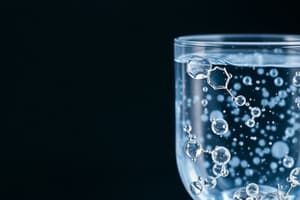Podcast
Questions and Answers
What defines an aqueous solution?
What defines an aqueous solution?
- It is a solution with a solid solute.
- It is a solution that is acidic in nature.
- It is a solution in which water is the solvent. (correct)
- It is a solution containing multiple phases.
Which of the following statements is true regarding hydrophilic substances?
Which of the following statements is true regarding hydrophilic substances?
- They have an affinity for water. (correct)
- They have no interaction with water.
- They repel water molecules.
- They do not dissolve in water.
What is the primary reason water is termed 'the solvent of life'?
What is the primary reason water is termed 'the solvent of life'?
- It readily forms hydrogen bonds. (correct)
- It is the only solvent known.
- It has a high boiling point.
- It can only dissolve ionic compounds.
In the context of water dissociation, what does a hydroxide ion (OH-) represent?
In the context of water dissociation, what does a hydroxide ion (OH-) represent?
How is molarity defined?
How is molarity defined?
What is the effect of adding an acid to a solution?
What is the effect of adding an acid to a solution?
Which of the following describes a solute?
Which of the following describes a solute?
What occurs during the hydration of an ionic compound in water?
What occurs during the hydration of an ionic compound in water?
What happens to the concentrations of H+ and OH- in pure water?
What happens to the concentrations of H+ and OH- in pure water?
Why are changes in pH significant for living organisms?
Why are changes in pH significant for living organisms?
What property of water allows it to absorb and release heat with minimal temperature change?
What property of water allows it to absorb and release heat with minimal temperature change?
Which process describes water's ability to cool itself as it evaporates?
Which process describes water's ability to cool itself as it evaporates?
How does cohesion in water contribute to plant life?
How does cohesion in water contribute to plant life?
What characteristic of ice causes it to float on water?
What characteristic of ice causes it to float on water?
What term describes the measure of how difficult it is to break the surface of a liquid?
What term describes the measure of how difficult it is to break the surface of a liquid?
What role does water play in temperature moderation?
What role does water play in temperature moderation?
What is the heat of vaporization in the context of water?
What is the heat of vaporization in the context of water?
Which statement about hydrogen bonds in water is correct?
Which statement about hydrogen bonds in water is correct?
What is an emergent property of water that is crucial for life on Earth?
What is an emergent property of water that is crucial for life on Earth?
How does adhesion in water assist plants?
How does adhesion in water assist plants?
Flashcards
Polarity in water
Polarity in water
Water's uneven distribution of charge, creating positive and negative ends.
Hydrogen bonds
Hydrogen bonds
Attractive forces between a hydrogen atom and an electronegative atom (like oxygen).
Cohesion
Cohesion
Attraction between like molecules (e.g., water to water).
Surface tension
Surface tension
Signup and view all the flashcards
High specific heat
High specific heat
Signup and view all the flashcards
Evaporation
Evaporation
Signup and view all the flashcards
Evaporative cooling
Evaporative cooling
Signup and view all the flashcards
Heat of vaporization
Heat of vaporization
Signup and view all the flashcards
Ice floats
Ice floats
Signup and view all the flashcards
Water as a solvent
Water as a solvent
Signup and view all the flashcards
Solution
Solution
Signup and view all the flashcards
Solvent
Solvent
Signup and view all the flashcards
Solute
Solute
Signup and view all the flashcards
Aqueous solution
Aqueous solution
Signup and view all the flashcards
Hydrophilic substance
Hydrophilic substance
Signup and view all the flashcards
Hydrophobic substance
Hydrophobic substance
Signup and view all the flashcards
Molarity
Molarity
Signup and view all the flashcards
Acid
Acid
Signup and view all the flashcards
Dissociation of water
Dissociation of water
Signup and view all the flashcards
pH scale
pH scale
Signup and view all the flashcards
Study Notes
Chapter 3: Water and Life
- Water is a polar molecule due to polar covalent bonds
- Opposite ends of the water molecule have opposite charges
- Polarity allows water molecules to form hydrogen bonds with each other
- Water's electron arrangement gives oxygen two partial negative charges
- Hydrogen bonds between water molecules give water unique properties
- Hydrogen bonds are responsible for water's high surface tension which allows some insects to walk on water
- Water has high specific heat; large amounts of heat are absorbed or released with only slight temperature fluctuations
- Water's specific heat stabilizes temperatures
- Evaporation is the transformation of a substance from liquid to gas
- Heat of vaporization is the heat a liquid needs to absorb for 1 gram to be converted to gas
- Evaporative cooling occurs when a liquid evaporates, its remaining surface cools
- Water's high specific heat and evaporative cooling help stabilize temperatures in organisms and bodies of water
- Ice floats in liquid water because hydrogen bonds in ice are more ordered and make ice less dense
- If ice sank, all bodies of water would eventually freeze solid, which makes life impossible on Earth
- A solution is a mixture that is homogeneous; a liquid dissolving agent is a solvent
- A solute is the substance that is dissolved in a solution
- Water is a versatile solvent due to its polarity
- Water is an effective solvent because it readily forms hydrogen bonds
- When an ionic compound is dissolved in water, each ion is surrounded by a sphere of water molecules; this is called a hydration shell
- Most biochemical reactions occur in water, and reactions depend on the concentration of solutes; these factors are important for the chemistry of a cell
- Molecular mass is the sum of the masses of all the atoms in a molecule. Numbers are usually measured in moles where one mole=6.02 x 10^23 molecules.
- Molarity is the number of moles of solute per liter of solution
- Water dissociation releases hydrogen ions (H+) and hydroxide ions (OH-)
- The hydrogen atom leaves its electron behind and is transferred as a proton; molecules with an extra proton are known as hydronium ions (H3O+). Molecules that lose a proton are known as hydroxide ions (OH-)
- The concentration of H+ and OH- is equal in pure water; adding acids and bases modifies the concentrations
- Biologists use the pH scale to describe how acidic or basic something is
- An acid increases the H+ concentration in a solution
- A base reduces the H+ concentration in a solution
- The pH of a solution is determined by the relative concentration of hydrogen ions
- Acidic solutions have pH values lower than 7
- Basic solutions have pH values greater than 7
- Most biological fluids have a pH value between 6 and 8
- Buffers are substances that minimize changes in the H+ and OH- concentration in solutions
- Most buffers consist of an acid-base pair that combines reversibly with hydrogen ions
The Threat of Acid Precipitation
- Acid precipitation refers to rain, snow, or fog below a pH of 5.6
- Acid precipitation is a result of pollutants mixing with the water in the air
- Acid precipitation damages life in lakes and streams
- It also affects soil chemistry, which then leads to the decline of forests.
Studying That Suits You
Use AI to generate personalized quizzes and flashcards to suit your learning preferences.



